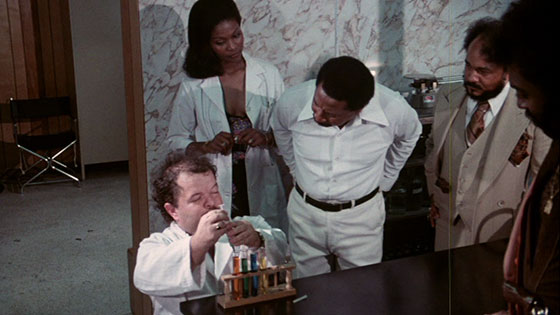If there’s one advantage to seeing the most-talked-about film (at least in my circle of admittedly “weird” friends and acquaintances) of 2015 so far six or so weeks after it came out — a delay necessitated by the fact that I promised my dad I’d take him with me to see it and my folks were out of town for a couple of months so we saved it for out Father’s Day “thing to do” — it’s that I was able to go into Mad Max : Fury Road with only the preconception that it was probably going to be good, maybe even damn good, and it didn’t need to live up to either all the perhaps-a-bit-inflated praise it received right out of the gate, given that the inevitable backlash wave that started hitting a week or two later had the predictable result of tempering my expectations somewhat.
Not that said backlash wave was all that severe, mind you — while too many people to count were saying this was “the best mainstream Hollywood action movie in at least a decade,” the harshest criticism the naysayers could come up with was stuff along the lines of “hold your horses, folks — yeah, it’s good, but it’s honeslty not even the best Mad Max flick.”
Here’s the funny thing, though — both statements are probably true.
Mad Max : Fury Road quite likely is the best mainstream Hollywood action movie to come down the pipeline in at least a decade (at least I can’t think of any better ones that spring to mind), but it’s also still not as flat-out awesome as The Road Warrior. Which isn’t too big a knock on it considering that those are some pretty big shoes to fill. So why not just take it for what it is? The highly unexpected return of the seminal “post-apocalyptic” movie franchise of all time that ably demonstrates that creator/director/co-writer George Miller not only hasn’t lost a step, but is far more youthful, energetic, and imaginative than most filmmakers less than half his age.
Seriously. Watching this thing you’d hardly guess that it’s the product of a 71-year-old industry veteran whose last efforts were the highly popular (and lucrative, as Miller’s work tends to be — maybe it’s time he got some of the credit he deserves) Happy Feet animated films. Precisely how he was able to convince Warner Brothers to give him $150 million to take his cast and crew over to Namibia and shoot a spectacular series of explosions, car chases, and other assorted ultraviolent bad-assery in service of resurrecting a storyline that’s been laying dormant for over 30 years is anybody’s guess, but we should all be damn glad that his powers of persuasion seem to fall into the realm of the superhuman.
As surprising as it is that Mad Max : Fury Road even managed to get made, though, rest assured that Miller hardly exhausted his bag of tricks behind the camera, because there are some genuine surprises that play out in front of it, as well — chief among them being that solo drifter of the irradiated wastelands Max Rockatansky (and if you thought Mel Gibson’s seminal iteration of the character was a man of few words, wait until you see Tom Hardy’s stoic and near-silent performance here) is more or less relegated to being an also-ran in his own movie, with the main focus here falling on Chralize Theron’s Imperator Furiosa, renegade escapee of an insane patriarchal quasi-society known as “The Citadel,” where a triumvirate of old-timers run the show and train the men to be unquestioningly loyal servants dripping with evangelical zeal while the women are reduced to being brood mares pumping out future generations of, one assumes, increasingly-inbred offspring.
Damn. Of all the religious groups to survive World War 3, it would have to be the Mormons.
The astonishing advances made in the realm of CGI since last we visited the desert wastes of post-nuke Australia (by way of Africa) certainly mean that Mad Max : Fury Road is the best-looking entry in the series, but it’s this film’s great leap forward in terms of attitude that most sets it apart from both its predecessors and its competition at the box office today. Simply put, this flick is pure punk rock in a way that its trio of progenitors, which generally took themselves pretty seriously, weren’t. Sure, the souped-up cars, tankers, dune buggies, and assault vehicles are ‘roid-enlarged to greater heights of absurdity than ever as one would expect, but when the villains go into battle led by a maniac guitarist whose instrument shoots flames from its neck, well — you know that no one’s too terribly concerned with presenting anything like a “realistic” take on what life would be like after “the big one.”
I think that’s a good thing — a damn good thing, in fact — and like the best punk music, Miller and fellow screenwriters Nico Lathouris and Brendan McCarthy (yes, comic book fans, that Brendan McCarthy — former frequent collaborator with Peter Milligan and co-creator of such visually transgressive and mind-bending fare as Skin and Rogan Gosh, Star Of The East — I think it’s safe to say that a lot of this “in-your-face” punk sensibility I keep harping on about can be directly traced back to his influence) have hidden a very relevant message about sexism and the death-spiral trap of uber-masculinity under all the operatic chaos on display here, which means that Mad Max : Fury Road isn’t just the best mainstream Hollywood action flick in at least ten years, but also the smartest and , perhaps paradoxically given how over-the-top (to say the least!) everything playing out in front of us is, the most relevant as well.
Then again, delicious irony has always been a punk staple, too, hasn’t it?
































